Did you know that the tech industry contributes to 2 to 3% of global greenhouse gas emissions? This startling fact underscores the urgent need for innovative solutions to reduce our environmental footprint. Enter green technology, a term that encompasses eco-friendly innovations designed to promote sustainability and clean energy practices1.
Green tech is not just a buzzword; it’s a transformative approach to addressing environmental challenges. From renewable energy sources like solar power to energy-efficient hardware, these advancements are reshaping the future of industries. For instance, adopting sustainable IT practices can reduce energy consumption by up to 65%, showcasing the potential for significant cost savings and environmental benefits2.
Moreover, the integration of biodegradable materials and predictive maintenance systems further minimizes waste and extends the lifespan of products. As companies increasingly invest in renewable energy, the impact of green technology continues to grow, paving the way for a more sustainable future3.
Key Takeaways
- Green technology reduces environmental impact through innovative solutions.
- Renewable energy sources like solar power are key to sustainability.
- Energy-efficient hardware can significantly lower energy consumption.
- Predictive maintenance extends product lifespans and reduces waste.
- Investments in green tech lead to long-term cost savings.
Introduction to Sustainable Technology and Glossary Terms
Understanding sustainable tech starts with knowing the terms that define it. This glossary aims to demystify key concepts, making it easier to grasp how eco-friendly innovations are shaping our world. From energy efficiency to waste reduction, these terms are the building blocks of a cleaner future.
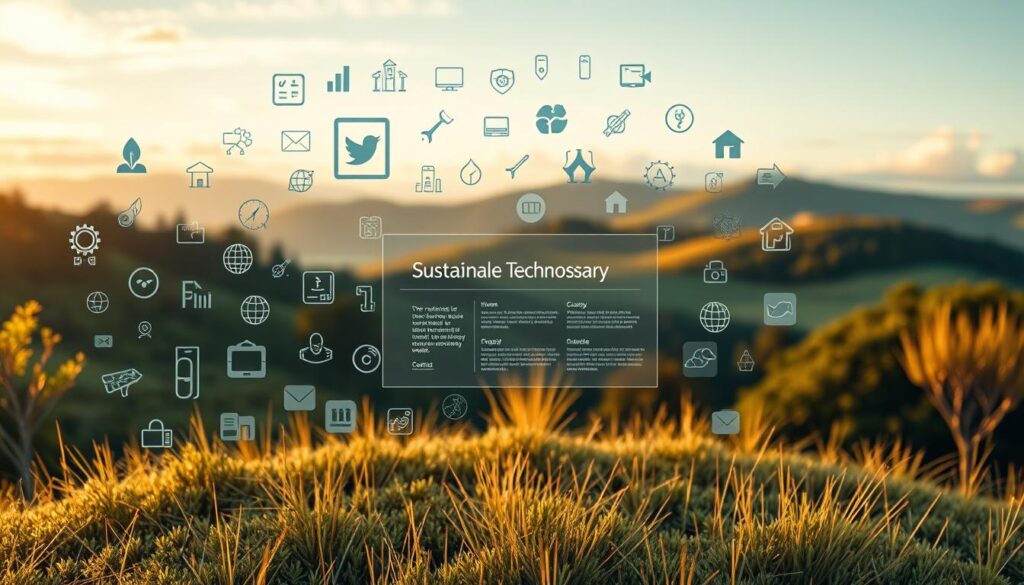
Purpose of this Glossary
The goal of this glossary is to provide clear definitions of commonly used terms in sustainable tech. By breaking down complex ideas, we aim to help readers understand how these innovations are applied in real-world scenarios. For example, terms like “clean tech” and “renewable energy” are often used interchangeably, but they have distinct meanings and applications4.
Overview of Sustainable Technology
Sustainable tech encompasses a wide range of practices and innovations designed to reduce environmental impact. This includes energy-efficient systems, advanced recycling methods, and the use of renewable resources. Companies and governments are increasingly adopting these practices to build portfolios that promote eco-friendly solutions5.
Historically, initiatives like the first major U.S. recycling program during World War II laid the groundwork for modern sustainable practices. Today, advancements in solar power and wind energy are leading the charge, with these sources projected to account for 71% of new energy capacity by 20244.
By understanding these terms and their applications, we can better appreciate how sustainable tech is transforming industries and protecting our environment.
Key Aspects of green technology
The rise of eco-friendly innovations is reshaping industries worldwide. These advancements focus on reducing environmental impact while driving economic growth. From renewable energy to efficient systems, the scope of these solutions is vast and continually evolving.
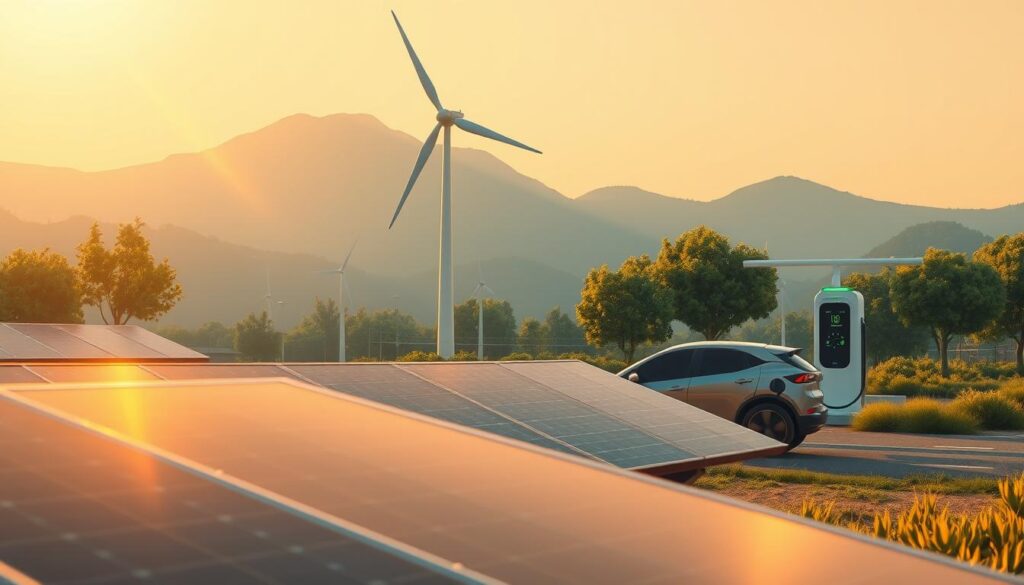
Definition and Scope
Green technology encompasses a wide range of practices aimed at sustainability. It includes the use of renewable power sources like solar and wind energy. These systems are designed to replace traditional fuels, reducing greenhouse gas emissions and promoting a circular economy6.
Core processes involve converting alternative fuels and optimizing energy consumption. For example, wind power systems harness natural resources to generate electricity efficiently. Such innovations are not only environmentally beneficial but also cost-effective in the long run7.
Environmental and Economic Benefits
Adopting green technology offers significant environmental advantages. It helps mitigate climate change by reducing reliance on fossil fuels. For instance, solar energy systems can lower carbon footprints while providing reliable power6.
Economically, these solutions lead to substantial cost savings. Companies investing in renewable energy can reduce operational expenses and avoid regulatory fines. Additionally, the shift toward sustainable practices creates new job opportunities in sectors like energy efficiency and environmental management8.
Effective system designs in green technology support both environmental and economic growth. By integrating advanced processes, industries can achieve a balance between profitability and sustainability. This dual benefit makes green technology a cornerstone of modern innovation.
Types of Sustainable Technology Solutions
Innovative solutions are transforming how we approach sustainability in modern industries. From renewable energy to waste management, these advancements are reducing our reliance on fossil fuels and minimizing environmental harm. Below, we explore key areas where sustainable practices are making a significant impact.
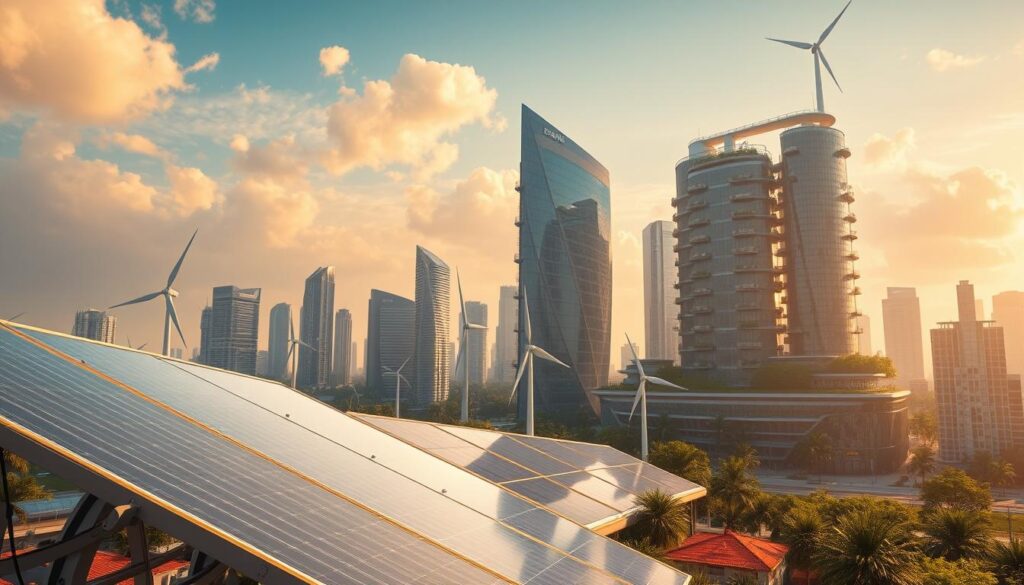
Alternative Energy Sources
Renewable energy is at the forefront of sustainable solutions. Solar and wind power are leading the charge, offering cleaner alternatives to traditional energy sources. For example, solar panels can reduce carbon emissions by up to 8,000 pounds annually for a typical household9.
Wind energy is equally impactful, accounting for 7.2% of global electricity generation in 20209. These systems not only lower emissions but also provide long-term cost savings, making them a practical choice for both individuals and businesses.
Electric and Hybrid Vehicles
The transportation industry is undergoing a major shift with the rise of electric and hybrid vehicles. These vehicles can reduce greenhouse gas emissions by 50–70% compared to gasoline-powered cars9.
For instance, cities adopting electric buses have seen air pollution drop by 30% to 50%10. This transition is not only environmentally beneficial but also economically advantageous, as EVs often have lower fuel and maintenance costs.
Recycling and Waste Management
Effective waste management is another critical aspect of sustainability. Innovations like automated sorting systems have improved recycling rates by up to 50%10. Composting is also gaining traction, reducing methane emissions from landfills.
For example, Seattle has implemented regulations that prohibit food waste in trash bins, encouraging composting practices9. These solutions highlight how recycling and waste management can contribute to a circular economy.
| Solution | Environmental Benefit | Economic Advantage |
|---|---|---|
| Solar Energy | Reduces carbon emissions by 8,000 lbs/year | Long-term cost savings |
| Wind Energy | Prevents 1.1 billion metric tons of CO2 emissions | Cost-effective energy production |
| Electric Vehicles | Cuts emissions by 50–70% | Lower fuel and maintenance costs |
| Recycling Systems | Improves recycling rates by 50% | Reduces waste management expenses |
Industry Applications and Innovations in Clean Energy
The integration of clean energy solutions into industrial processes is revolutionizing how industries operate. From manufacturing to IT infrastructure, these innovations are reducing reliance on traditional energy sources and fostering a more sustainable future.
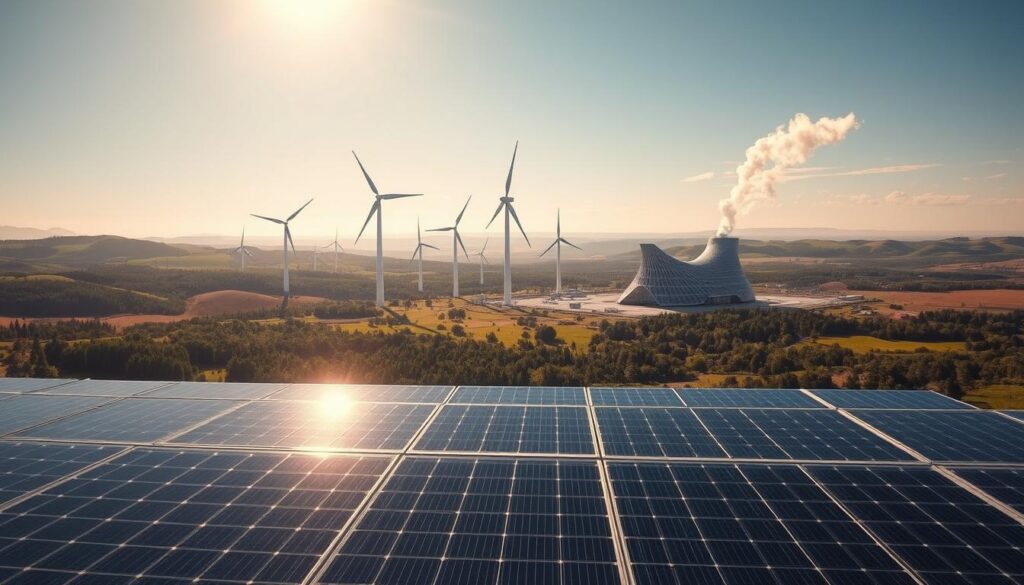
Innovative Industrial Processes
Industries are adopting advanced methods to minimize their environmental footprint. For example, electric vehicle production has surged, with companies leveraging renewable energy to power their factories. This shift not only reduces emissions but also lowers operational costs11.
Another breakthrough is the use of carbon capture techniques in heavy industries. These methods prevent harmful gases from entering the atmosphere, significantly reducing pollution levels12.
Solid-state batteries are also transforming energy storage. With higher energy density and safety, they are becoming a preferred choice for large-scale renewable energy installations11.
Sustainable IT and Infrastructure
The IT sector is embracing clean energy to power data centers and networks. Artificial intelligence is optimizing energy distribution, predicting demand, and managing storage efficiently11.
For instance, solar and wind capacity additions accounted for close to 90% of all new builds in 202412. This trend highlights the growing reliance on renewable sources in IT infrastructure.
Data centers are projected to drive 44 GW of additional demand by 2030, with renewable energy playing a crucial role in meeting this need12.
| Innovation | Application | Impact |
|---|---|---|
| Electric Vehicles | Manufacturing | Reduces emissions by 50–70% |
| Carbon Capture | Heavy Industries | Lowers pollution levels |
| Solid-State Batteries | Energy Storage | Enhances safety and efficiency |
| AI in IT | Energy Management | Optimizes distribution and storage |
“The future of energy lies in the seamless integration of renewable sources and advanced technologies.”
Overcoming Challenges and Adoption Barriers
The shift toward eco-friendly solutions is not without its obstacles. Businesses and governments face significant hurdles in adopting sustainable practices. These challenges range from financial constraints to infrastructural deficiencies, slowing down progress despite the clear benefits.

Financial and Policy Challenges
High upfront costs remain a major barrier to adopting renewable energy systems. For example, solar panels and wind turbines require substantial initial investments, deterring many businesses13. Additionally, policy uncertainties and insufficient financial incentives further complicate the transition. Over 8,000 companies have committed to net-zero emissions, but inconsistent regulations hinder their efforts14.
Tax breaks and subsidies are critical to making renewable energy more accessible. However, delays in federal support, such as tax credits, leave many businesses vulnerable during economic stress15. Strengthening policy frameworks and providing consistent financial incentives are essential to overcoming these challenges.
Infrastructure and Supply Chain Hurdles
Infrastructure deficiencies pose another significant challenge. Upgrading transmission and grid systems is necessary to accommodate the increasing share of renewable energy13. For instance, the “Dunkelflaute” phenomenon highlights the need for advanced energy storage solutions during periods of low wind and solar generation13.
Supply chain issues, such as the global lithium shortage, also impact the renewable energy sector. Lithium-ion batteries are essential for energy storage, but their production faces environmental and logistical challenges13. Addressing these hurdles requires innovative solutions and collaborative efforts across industries.
| Challenge | Impact | Solution |
|---|---|---|
| High Initial Costs | Deters investment in renewable energy | Tax breaks and subsidies |
| Policy Uncertainties | Hinders progress toward net-zero goals | Strengthened regulatory frameworks |
| Infrastructure Deficiencies | Limits renewable energy integration | Grid upgrades and energy storage |
| Supply Chain Issues | Disrupts battery production | Innovative logistics and recycling |
“The transition to renewable energy requires not just innovation but also robust policy and infrastructure support.”
Future Trends and Impact on Business and the Environment
The future of sustainability is being shaped by groundbreaking innovations and strategic business practices. Companies are increasingly adopting eco-friendly solutions to reduce their environmental footprint while maintaining economic growth. From advanced carbon capture to low-carbon construction, these trends are transforming industries and ecosystems alike16.
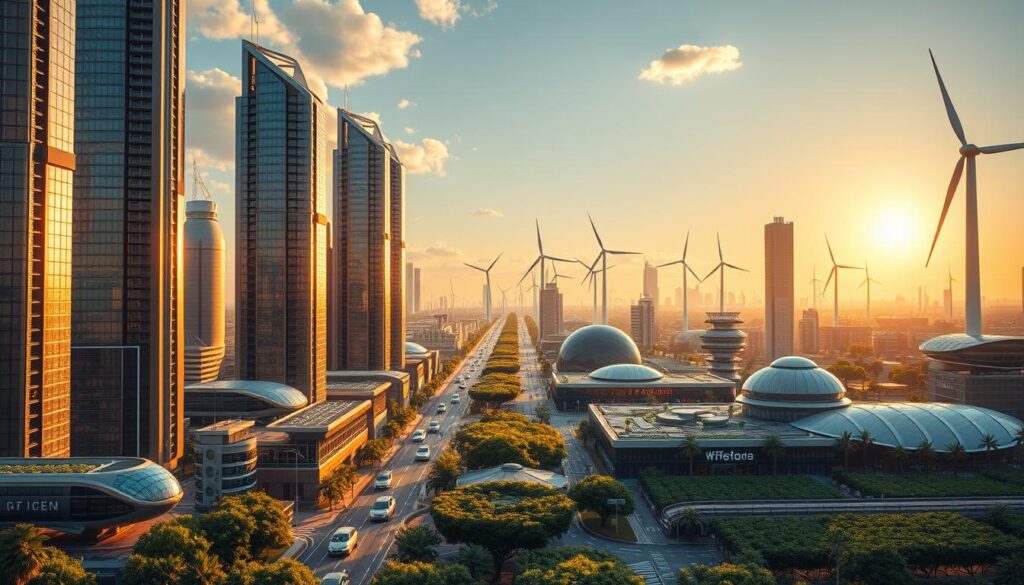
Business Integration of Sustainable Practices
Businesses are integrating sustainable practices into their core strategies to stay competitive. For example, companies are adopting closed-loop systems to maximize material reuse and reduce waste17. This approach not only minimizes pollution but also enhances operational efficiency.
By 2030, the global market for sustainability solutions is projected to reach $137.4 billion, driven by increased demand for renewable energy and efficient resource management16. This growth highlights the economic benefits of embracing eco-friendly practices.
Advancements and Regenerative Solutions
Technological advancements are playing a crucial role in promoting sustainability. Innovations like carbon capture are helping industries reduce greenhouse gas emissions significantly18. These methods are particularly impactful in agriculture, where they improve soil health and reduce environmental harm.
Regenerative solutions are also gaining traction. For instance, sustainable agriculture practices are enhancing food production while preserving ecosystems17. These methods ensure responsible consumption and long-term environmental health.
| Trend | Impact | Example |
|---|---|---|
| Carbon Capture | Reduces greenhouse gas emissions | Industrial applications in heavy industries |
| Low-Carbon Construction | Minimizes environmental pollution | Use of recycled materials in building projects |
| Sustainable Agriculture | Preserves ecosystems | Regenerative farming techniques |
“The integration of sustainable practices is not just an environmental imperative but a strategic business advantage.”
Conclusion
Sustainable innovations are reshaping industries, offering a path toward a cleaner and more efficient future. Throughout this article, we’ve explored how renewable energy, efficient systems, and advanced recycling methods are reducing environmental impact while driving economic growth. The integration of these practices into business strategies is essential for long-term success and resilience.
Government policies and corporate initiatives play a critical role in accelerating this change. By prioritizing sustainability, businesses can not only reduce costs but also contribute to the conservation of natural resources. For instance, the global sustainability market is projected to reach $79.65 billion by 2030, highlighting the economic potential of these solutions19.
Looking ahead, the focus must remain on innovation and collaboration. From solar energy to electric vehicles, every step toward sustainability brings us closer to a healthier world. By managing resources effectively and embracing renewable sources, we can ensure a brighter future for generations to come.
FAQ
What is sustainable technology?
How does sustainable technology benefit the environment?
What are some examples of alternative energy sources?
How do electric and hybrid vehicles contribute to sustainability?
What role does recycling play in sustainable technology?
What challenges do businesses face when adopting sustainable technology?
How can businesses integrate sustainable practices effectively?
What are the future trends in sustainable technology?
How does sustainable technology impact economic growth?
Source Links
- Green Tech: 5 Sustainability Innovations in the Tech Industry – https://mondo.com/insights/green-tech-sustainability-innovations-in-the-tech-sector/
- Sustainable Technology Solutions: The Smart Choice for IT – https://sustaia.com/sustainable-technology-solutions/
- Green IT in 2024: What It Is and Why It Matters More Than Ever – Evernex – https://evernex.com/industry-guide/green-it/
- What Is Green Tech? How It Works, Types, Adoption, and Examples – https://www.investopedia.com/terms/g/green_tech.asp
- What Is Green Technology? | IBM – https://www.ibm.com/think/topics/green-technology
- Green Technology: A Game-Changer for Sustainability | PrimeIT – https://www.primeitconsulting.ch/en/green-technology-a-game-changer-for-sustainability/
- Green Technology: Innovations Driving Sustainability in IT – Atlanta Technology Professionals – https://atpconnect.org/green-technology-innovations-driving-sustainability-in-it/
- Everything You Need to Know About Green Technology in 2025 – https://greenly.earth/en-us/blog/industries/everything-you-need-to-know-about-green-technology-in-2022
- Green Technology Examples: Innovative Solutions for a Sustainable Future – https://www.electropages.com/blog/2019/09/what-is-green-technology
- Sustainable Tech for a Greener Tomorrow | Green City Times – https://www.greencitytimes.com/sustainable-tech-for-a-greener-tomorrow/
- Innovations in Renewable Energy: What’s New in 2024 | SmartEnergy – https://smartenergy.com/innovations-in-renewable-energy-whats-new-in-2024/
- 2025 Renewable Energy Industry Outlook – https://www2.deloitte.com/us/en/insights/industry/renewable-energy/renewable-energy-industry-outlook.html
- Overcoming Challenges in Adopting Renewable Energy Tech – https://blog.feniceenergy.com/overcoming-challenges-in-adopting-renewable-energy-tech/
- Overcoming Hurdles to Sustainable Innovation – https://www.shrm.org/enterprise-solutions/insights/overcoming-adoption-hurdles-to-sustainable-innovation
- The Funding Gap in Green Technology: A Barrier to Progress – https://www.sourcengine.com/blog/the-funding-gap-in-green-technology-a-barrier-to-progress?srsltid=AfmBOormXTMDs2hQWfnPiEfrDCiK-CE0KCakSUI_1wHL_HJ72wB1hsdj
- Green Technology & Sustainability Strategic Business Report 2025, with ABB, AMCS Group, BT, Cority, CropX, EcoCart, ENGIE Impact, GE Vernova, Huawei Technologies & more – https://www.globenewswire.com/news-release/2025/02/25/3032127/28124/en/Green-Technology-Sustainability-Strategic-Business-Report-2025-with-ABB-AMCS-Group-BT-Cority-CropX-EcoCart-ENGIE-Impact-GE-Vernova-Huawei-Technologies-more.html
- Top 5 Sustainable Business Trends for 2025 • Presidio Graduate School – https://www.presidio.edu/blog/top-5-sustainable-business-trends-for-2025-what-future-leaders-need-to-know/
- Sustainability trends businesses must watch in 2025 – I by IMD – https://www.imd.org/ibyimd/2025-trends/sustainability-trends-businesses-must-watch-in-2025/
- What is Green Technology and can Developing Countries Afford it? — Futurize – https://www.futurize.studio/blog/what-is-green-technology
